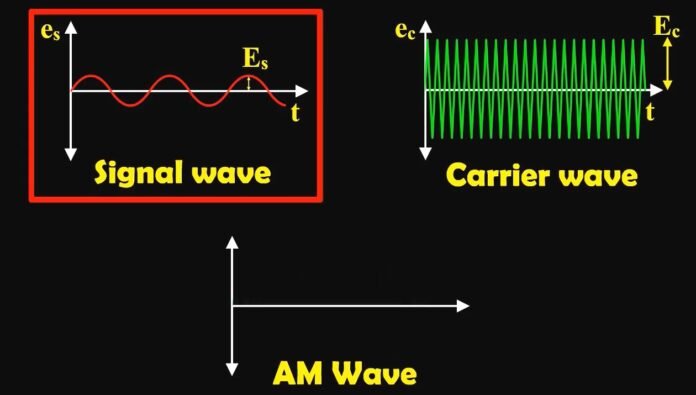Amplitude modulation (AM) is a modulation technique used in communication systems to transmit information over a carrier wave by varying its amplitude.
The process of modulating the carrier wave with the information signal is known as modulation, and the resulting waveform is called the modulated signal.
The derivation of amplitude modulation involves combining the carrier wave and the information signal using a nonlinear device called a modulator. The modulator multiplies the carrier wave with the information signal, producing a modulated signal that varies in amplitude with the information signal.
What is Amplitude Modulation
Amplitude Modulation (AM) is a method of transmitting information over a radio wave by varying the amplitude (or strength) of the carrier wave to reflect the changes in the amplitude of the original signal.
In AM, the carrier wave’s frequency remains constant, while the amplitude changes in response to the modulating signal.
Derivation of Amplitude Modulation
Amplitude Modulation (AM) is a modulation technique used in communication systems to transmit information over a carrier wave by varying the amplitude of the wave. Here is a derivation of AM-
m(t) = Amcos (2fmt) (modulating signal)
c(t) = Accos (2fct) (carrier signal)
s(t) = (Ac+ Amcos (2fmt)) cos(2fct)
Where,
Am = Amplitude of Modulating signal
Ac = Amplitude of Carrier signal
Modulation Index Derivation
Modulation index is a term used in the context of modulation techniques. It is a measure of the degree to which a carrier signal is modulated by a modulating signal.
= Am / Ac
Let the maximum and minimum amplitude of the wave are Amax and Amin
Amax = Ac + Am
Amin = Ac – Am
Amax + Amin = Ac + Am + Ac – Am = 2 Ac
Ac = (Amax + Amin) / 2
Amax – Amin = Ac + Am – Ac + Am = 2 Am
Am = (Amax – Amin) / 2
= Am / Ac
This is the derivation of modulation index.
Types of Amplitude Modulation
Amplitude modulation (AM) is a type of modulation in which the amplitude of a carrier wave is varied in proportion to the amplitude of a modulating signal. There are several types of amplitude modulation, including-
Double Sideband (DSB) AM: In this type of AM, both the upper and lower sidebands are transmitted. The carrier wave is suppressed, and only the sidebands are transmitted. DSB is commonly used in radio broadcasting.
Single Sideband (SSB) AM: This type of AM suppresses one of the sidebands and the carrier wave, leaving only one sideband for transmission. SSB is more efficient than DSB because it uses less bandwidth.
Vestigial Sideband (VSB) AM: This type of AM transmits both sidebands but partially suppresses one of the sidebands. VSB is used in television broadcasting to reduce the bandwidth required for transmission.
Advantage and Disadvantage of Amplitude Modulation
AM involves varying the amplitude of a high-frequency carrier wave to carry information. AM has several advantages, it also has some disadvantages, which are discussed as-
Advantages of Amplitude Modulation
Simplicity: AM is a simple modulation technique that requires only a few basic components, making it easy and inexpensive to implement.
Compatibility: AM signals can be easily demodulated using a simple detector circuit, making it compatible with a wide range of receivers.
Disadvantages of Amplitude Modulation-
Susceptible to noise: One of the primary disadvantages of AM is its susceptibility to noise. The amplitude of the signal can be affected by external noise sources, resulting in a degraded signal quality.
Limited bandwidth: AM has a limited bandwidth, which restricts the amount of information that can be transmitted.
Interference: Another disadvantage of AM is that it is susceptible to interference from other radio signals, which can result in poor signal quality.
